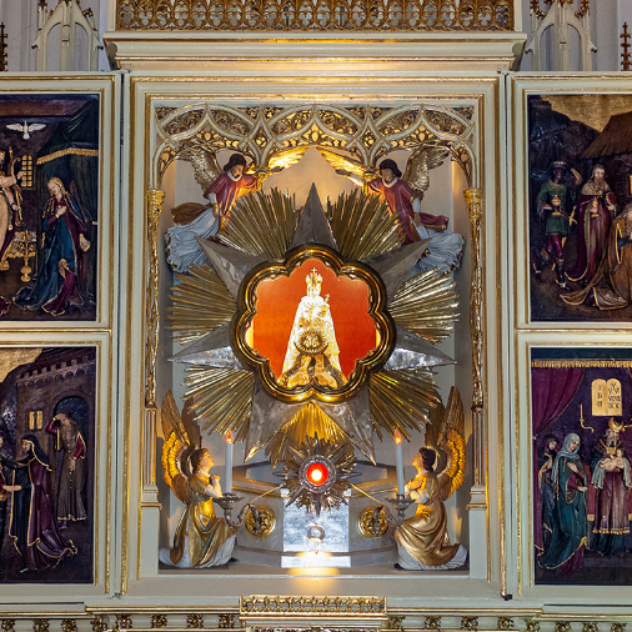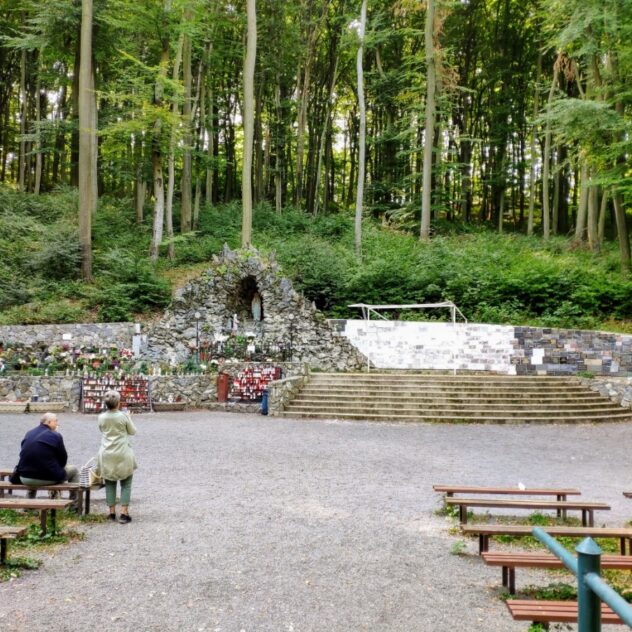Basilica of the Nativity of the Virgin Mary in Marianka
Information about the pilgrimage site
Marianka is one of the oldest pilgrimage sites in Europe as well as in the territory of today’s Slovakia. At the same time, this place is one of the most famous in the entire ancient Hungarian Empire. There were periods in history when this place was visited by 50,000 pilgrims. The name of the Marian pilgrimage site comes from the name of the Virgin Mary, to whom it is dedicated.
The origin of the pilgrimage site is connected with the legend of the statue of the Virgin Mary. The creation of the statue of the “Madonna of Tál”, which is 42 centimetres high, dates back to 1030. It was probably carved out of pear wood or found by a bandit living in the local forest who had seriously ill children. While praying, the Mother of God appeared to him and promised him that if he bathed his children in the spring where he found her statue, his children would get well. And so it happened. Word of this place and spring spread quickly as other people found their prayers answered here. At first, the statue was placed on a wooden post by the well, and later it was moved to the adjacent Church of the Nativity of the Virgin Mary.
Marianka was under the administration of the Pauline Order for 400 years – until 1786, when Emperor Joseph II dissolved all the orders in the Austro-Hungarian monarchy. The new development of the pilgrimage site began in 1927 with the arrival of the brothers of the Comforters until 1950, when the communist regime severely restricted religious life in the country. After November 1989 they returned to Marianka and have remained there ever since.
At present, the area of the pilgrimage site consists of several sacral buildings, mainly from the Baroque period. The most important monument is the aforementioned church and the adjacent monastery, which served the order of the Paulines. Today it is used for exorcisms and as a pilgrimage house and is administered by the Order of the Comforters. There is also the Chapel of St. Anne. From the church to the holy spring there is the so-called Marian Way, which consists of six chapels themed on the life of the Virgin Mary. At the end of the Marian Way there is a chapel over the Holy Well with a dome under which there is a spring of water. A significant part of the pilgrimage site is the Way of the Cross, which is situated in a beech wooded slope. Its composition consists of 50 life-size wooden statues. Below the Stations of the Cross is the Lourdes Cave. On its walls there are a number of plaques left by people as thanksgiving for answered prayers.
Pilgrims have been coming to the Marian pilgrimage site for over 900 years because it is a place of silence, prayer and deepening of the relationship of man to God and the Mother of God. This place is also a popular destination for hikers and cyclists from near and far.
Tourist attractions in the vicinity
Bratislava – the capital of the Slovak Republic is also poetically referred to as the beauty on the Danube. It has not only a rich history, but also an interesting present. It lies on both banks of the Danube River and at the foot of the Little Carpathian Mountains. Bratislava is a combination of a vibrant big city with historical background combined with new architectural trends. This city has often played an important role in the history of Central Europe. The dominant feature of the city, which is visible from afar, is Bratislava Castle. The most attractive part of Bratislava with the greatest concentration of historical monuments and cultural institutions is the Old Town. The monuments in the historic centre of the city are part of the city monument reserve. Tours of Bratislava with different themes are offered by the City Information Centre.
Pajštún Castle – ruins. The original medieval castle, of which only a part of the walls has been preserved. The castle ruins offer a magnificent view of the Little Carpathians and the southern part of the Záhorská lowlands. In good weather you can see Borinka and even the Austrian Alps. You can start your hike to the castle at the church in the nearby village of Borinka. The route to the ruins can be found e.g. at https://www.hrady-zamky.sk/pajstun/.
Medené Hámre – is a former settlement in the cadastre of the village Borinka. This deserted place is attractive for its unique atmosphere. This former settlement is located in the middle of the beautiful nature of the Little Carpathians. The place is named after a former copper processing plant that was built here in the 18th century. Copper utensils and other copper products were produced there. Although the factory has now been demolished, the Baroque Chapel of St. Michael the Archangel has been preserved. It is a beautiful example of a small rural building. Its most striking feature is the original façade and the wooden tower with its onion-shaped roof.
Bratislava Calvary – a place of pilgrimage in the heart of Bratislava with an original story. It is located on Calvary Hill and was built among the first of its kind in Hungary. It commemorates the battle of Christian armies against Turkish troops near Vienna in 1683. Throughout its history it has witnessed prayers, miracles and healings. This is evidenced by the many thanksgiving plaques in the Lourdes Cave, which is in close proximity. However, this place has also gone through periods of decline, being almost completely razed to the ground during communism. However, it has been saved and has undergone a general reconstruction. Today it is a unique crossroads where modern architecture meets baroque and three hundred years of history meets the present.
Devín Castle – although the castle is a ruin, it is an important representative of Slovak national history. It rises above the confluence of the Danube and Morava rivers. It has one of the most moving, but also the richest histories among the castle settlements in Slovakia. The castle is depicted in numerous Slovak works of art. Today there is a museum where visitors can learn about the castle’s thousand-year history (https://hraddevin.mmb.sk/en/). A popular mode of transport to the castle is by cruise ship, which runs from the passenger port in Bratislava.
Accommodation
- Accommodation for pilgrims: the pilgrimage house, located directly in the pilgrimage area (https://bazilikamarianka.sk/putnicky-dom/)
- Other private accommodation in or around Marianka
Availability
By car
Access by car is the fastest. The eponymous village of Marianka, near which the pilgrimage site is located, is situated near the D2 motorway (exit Stupava Bory; Záhorská Bystrica, Marianka). Parking is near the pilgrimage site.
By public transport
From Bratislava (Patrónka stop) to Marianka (Marianka, Námestie stop) there is a suburban bus, line No. 215.
On foot
The oldest access to the pilgrimage site is on foot. There are several walking trails leading here. The most famous walking route for non-Bratislava pilgrims leads from the Bratislava district of Rača, which connects the two sides of the Little Carpathian Mountains. It is of easy to medium difficulty, 12 km long and 471 m above sea level. From the train station in Rača, the pilgrim takes the blue hiking trail that leads to the “Panova lúka” (Lord’s Meadow), from where the yellow trail continues to the “Malinský vrch” (Malinský Hill). From the place “Malinský vrch” you will again follow the blue trail which leads to the Basilica. Along the way there are several places suitable for sitting and a short rest. The second, quite frequented pilgrimage route leads directly from the city of Bratislava (in the tourist maps it is marked as M05-12) in front of the place “Bratislava Calvary”, which is part of the Marian Pilgrimage Route and its length is 15 km.
On a bicycle
There are several cycling routes to the Marianka pilgrimage site and they are very well signposted (several tourist maps are available online). Some of the cycle paths follow the tourist routes and some are only for cyclists.








